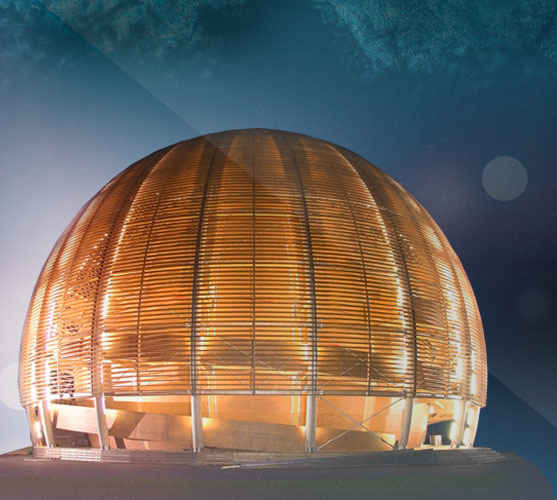Prince of Asturias Award for Technical & Scientific Research 2013



Cern
The European Organization for Nuclear Research (CERN), which retains the French acronym for the European Center for Nuclear Research that preceded it, is an international, intergovernmental organization based in Geneva (Switzerland) made up of twenty member states: Austria, Belgium, Bulgaria, Czech Republic, Denmark, Finland, France, Germany, Greece, Holland, Hungary, Italy, Norway, Poland, Portugal, Slovakia, Spain, Sweden, Switzerland and the UK. Other countries also participate in its work, while high-level institutions such as the European Commission and UNESCO have observer status. Opened in 1954, it currently employs about 2,500 people, including scientists and laboratory technicians. In addition, about 8,000 scientists of 85 nationalities from 580 universities are involved in its projects.
On 30th March 2010, scientists at CERN achieved what was then considered the greatest scientific experiment in the world:the collision, for the first time, of pre-accelerated proton beams to obtain an energy of 7 teraelectronvolts (TeV) inside the LHC, recreating conditions similar to those existing at the moment of the Big Bang. The creation of the first antimatter particle in the LHC provided confirmation of the physical theories which the facility is currently working with, such as Einstein's Theory of Relativity and the understanding of the formation of the Universe. In 2012, after half a century of conjectures, these findings enabled the existence of what is known as the Higgs boson or "God particle" to finally be demonstrated, as well as providing the means to complete the Standard Model of particle physics, i.e. the periodic table of the subatomic world and its rules, which explain how the universe works.
CERN had its first success in 1984 when two of its scientists won the Nobel Prize in Physics for the discovery of the W and Z bosons, weak interaction particles known as intermediate bosons. In 1990, it also saw the birth of the World Wide Web (www) protocol, invented by the British physicist Tim Berners-Lee, 2002 Prince of Asturias Award for Technical and Scientific Research, so that the scientists there could access data regardless of their geographic location.The production of isotopes for improving medical imaging and cancer therapies is another of the activities carried out at CERN, as is the development of methods for nuclear waste disposal, energy savings employing vacuum technology and energy storage and transport by means of superconductivity.
Cern History

1954CERN IS BORN
The European Organization for Nuclear Research (CERN) is founded in 1954. Located on both sides of the Franco-Swiss border near Geneva, CERN has twenty member states and is the largest particle physics laboratory in the world. It currently employs about 2,500 people, including scientists and laboratory technicians. In addition, about 8,000 scientists of 85 nationalities from 580 universities are involved in its projects.
1957FIRST PARTICLE ACCELERATOR
CERN's first accelerator, the Synchrocyclotron (SC), starts up.
1959PROTON SYNCHROTRON
The Proton Synchrotron (PS) starts up and becomes the world's largest particle accelerator.
1968PARTICLE DETECTION
In the 1960s, detection in particle physics mainly involved examining millions of photographs from bubble chambers or spark chambers, which was a slow, labour-intensive process.
In 1968, Georges Charpak developed the multiwire proportional chamber, which, linked to a computer, streamlined the process and revolutionized particle detection.
1971FIRST PROTON COLLISIONS
The first proton-proton collider in the world starts up: the Intersection and Storage Rings (ISR). Over the next thirteen years, the machine provided a unique view of the miniscule world of particle physics.
1976SUPER PROTON SYNCHROTRON
The Super Proton Synchrotron (SPS), the first particle accelerator to cross the border between France and Switzerland, starts up on 17th June.
1983DISCOVERY OF THE W and Z BOSONS
CERN announces the discovery of the W and Z particles after performing collision experiments between protons and antiprotons using the Super Proton Synchrotron (SPS).
1989LARGE ELECTRON-POSITRON COLLIDER
The Large Electron Positron Collider (LEP) -the largest electron-positron accelerator ever built- starts up. The measurements performed on the LEP show that there are three generations of particles of matter.
1990THE WORLD WIDE WEB PROTOCOL IS BORN
Whilst working as a research fellow at CERN, the European Particle Physics Laboratory, in Geneva, Tim Berners-Lee (2002 Prince of Asturias Award for Technical and Scientific Research) conceived the idea of a global hypertext project, which years later was to become the World Wide Web. He created a prototype in 1990, and in 1991 the Web began to exert far-reaching changes on the Internet environment of the time, to the point where the world's population can now access it.
1995FIRST ANTIATOMS PRODUCED
A team led by Walter Oelert created atoms of antihydrogen for the first time at CERN's Low Energy Antiproton Ring (LEAR) facility.
1997CMS AND ATLAS EXPERIMENTS
Four years after the first technical proposals, the experiments CMS and ATLAS were officially approved. Both experiments seek the Higgs boson, the particle which provides a mechanism to explain particle mass.
1998ALICE EXPERIMENT
The CERN research board officially approves the ALICE experiment. It is designed to study quark-gluon plasma, a state of matter that would have existed in the first moments of the universe.
1998LHCb EXPERIMENT
LHCb is the fourth experiment approved for the LHC. The experiment will study the phenomenon known as CP violation, which would help to explain why matter dominates antimatter in the universe.
2000LEP's SHUTDOWN
The Large Electron-Positron (LEP) collider was shut down for the last time on 2nd November 2000. With the tunnel now available for work, teams began excavating the caverns to house the four big detectors on the Large Hadron Collider (LHC).
200450th ANNIVERSARY
CERN celebrated its 50th birthday with the inauguration of the Globe of Science and Innovation. A gift from the Swiss Confederation, the Globe is an iconic wooden structure first used for the Swiss national exhibition in 2002 as a pavilion dedicated to the theme of sustainable development. The Globe is being developed into a new visitor and networking centre for the Laboratory - a focal point for CERN's interaction with society.
2008THE LHC STARTS UP
At 10:28am on 10th September 2008, a beam of protons was successfully steered around the 27-kilometre Large Hadron Collider (LHC) for the first time. The machine was ready to embark on a new era of discovery at the high-energy frontier.
LHC experiments address questions such as what gives matter its mass, what the invisible 96% of the universe is made of, why nature prefers matter to antimatter and how matter evolved from the first instants of the universe's existence.
2010CREATION OF THE FIRST ANTIMATTER PARTICLE
On 30th March 2010, scientists at CERN achieved what was then considered the greatest scientific experiment in the world: the collision, for the first time, of pre-accelerated proton beams to obtain an energy of 7 teraelectronvolts (TeV) inside the LHC, recreating conditions similar to those existing at the moment of the Big Bang.
The creation of the first antimatter particle in the LHC provided confirmation of the physical theories which the facility is currently working with, such as Einstein's Theory of Relativity and the understanding of the formation of the Universe.
2011ANTIMATTER ATOMS ARE TRAPPED FOR 1000 SECONDS
The ALPHA experiment at CERN reported today that it succeeded in trapping antimatter atoms for over 16 minutes: long enough to begin to study their properties in detail. ALPHA is part of a broad programme at CERN's antiproton decelerator investigating the mysteries of one of nature's most elusive substances.
2012THE HIGGS BOSON
Previous findings enabled the demonstration of the existence of what is known as the Higgs boson or "God particle" to finally be demonstrated, as well as providing the means to complete the Standard Model of particle physics, i.e. the periodic table of the subatomic world and its rules, which explain how the universe works.
Cern in 3 minutes
Cern Prince of
Asturias
Award
At its meeting in Oviedo, the Jury for the 2013 Prince of Asturias Award for Technical and Scientific Research, made up of Mr Juan Luis Arsuaga Ferreras, Mr Juan Ignacio Cirac Sasturáin, Mr Luis Fernández-Vega Sanz, Ms Cristina Garmendia Mendizábal, Ms María del Rosario Heras Celemín, Mr Bernardo Hernández González, Mr Emilio Lora-Tamayo D'ocón, Mr José Antonio Martínez Álvarez, Mr Amador Menéndez Velázquez, Ms María Teresa Miras Portugal, Mr Ginés Morata Pérez, Mr Enrique Moreno González, Mr César Nombela Cano, Mr Eduardo Punset Casals, Ms Marta Sanz-Solé, Mr Manuel Toharia Cortés, chaired by Mr Pedro Miguel Echenique Landiríbar and with Mr Vicente Gotor Santamaría acting as secretary, have unanimously decided to bestow the 2013 Prince of Asturias Award for Technical and Scientific Research jointly on physicists Peter Higgs (UK) and François Englert (Belgium) and the international institution CERN, the European Laboratory of Particle Physics, for the theoretical prediction and experimental detection of the Higgs boson.
In 1964, the pioneering work of Higgs and of Englert and Brout (the latter died in 2011) established the theoretical basis for the existence of the so-called Higgs boson. This particle completes the Standard Model, which describes the fundamental components of Nature, and is responsible for certain elementary particles possessing mass. For nearly half a century, efforts to find the Higgs boson were unsuccessful due to the enormous experimental difficulties associated with its precise and unequivocal detection. The Higgs boson was finally identified in 2012 by the ATLAS and CMS detectors of the LHC particle accelerator at CERN, a milestone for the entire scientific community.
The discovery of the Higgs boson is a prime example of how Europe has led a collective effort to solve one of the deepest mysteries of physics.
Oviedo, 29th May 2013